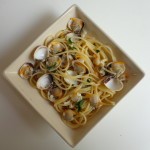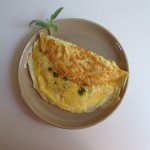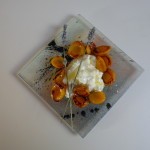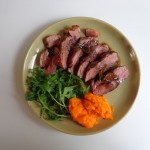 This recipe marries two of my favorite flavors — the wild, woodsy taste of black currants and the rich, warm taste of duck. Throw in a little garlic and thyme and you have an intensely satisfying dish for autumn, winter, or in fact any time of year.
This recipe marries two of my favorite flavors — the wild, woodsy taste of black currants and the rich, warm taste of duck. Throw in a little garlic and thyme and you have an intensely satisfying dish for autumn, winter, or in fact any time of year.
‘But wait!’ you may object. ‘What about all that duck fat?’ Yes, it’s true — a duck breast comes with a thick layer of fat on one side, while the other side is lean. The trick is to score the fat with a sharp knife, and to throw off the melted fat as the duck is cooking. This way your sauce will be flavor-packed without being heavy. And you can also — although this is anathema to most French — trim the fat off as you eat the duck. The great thing is that this recipe can be prepared quickly, and if guests are coming you can do it in two stages — the first before they arrive, and the second just before bringing the duck to the table.
Magret de canard au cassis / Duck breast with black currant sauce
Needless to say, this is one of those foods that falls under the heading ‘the French paradox’ — the way the French stay thin and live longer than the rest of us mortals despite consuming rich foods. In fact, according to official French statistics, life expectancy is higher in the region surrounding Toulouse — in southwest France, where the most duck is produced — than in any other part of the country except the capital.
Another part of the French paradox is that red wine seems to be beneficial to health if one does not overindulge. And duck pairs beautifully with a glass of the red — from southern France, or anywhere with wine robust enough to stand up to these intense flavors.
Here’s an update about this site, which has received an enthusiastic welcome from readers since it was launched last week. For which many thanks. First, some readers have pointed out that ingredients called for in these recipes are not available where they live. What is to be done? Later today I will add a new category to the menu bar, Ingredients, with advice on which food products to choose and what to substitute if you cannot find certain items. Second, while I am still experiencing some technical difficulties, the RSS feed on this site appears to be working. If you’d like to receive a daily alert telling you which recipe has been posted, simply click on the ‘Entries RSS’ line toward the bottom of the right-hand column on this page and sign up. I hope to have an RSS icon on the top of the page in the near future. Happy cooking!
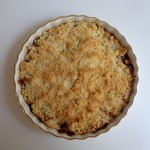 The crumble may have originated in Britain or Ireland or even America — nobody seems to know for sure — but the French have embraced it so wholeheartedly that it now pops up on menus of Parisian restaurants both humble and grand. Variations created over here include crumbles with everything from veggies to chicken to nuts. The fruit crumble, however, is the origin of the species, and among fruit crumbles, my favorites are with berries — black currants, red currants, blackberries or, as in this recipe, with blueberries.
The crumble may have originated in Britain or Ireland or even America — nobody seems to know for sure — but the French have embraced it so wholeheartedly that it now pops up on menus of Parisian restaurants both humble and grand. Variations created over here include crumbles with everything from veggies to chicken to nuts. The fruit crumble, however, is the origin of the species, and among fruit crumbles, my favorites are with berries — black currants, red currants, blackberries or, as in this recipe, with blueberries.

